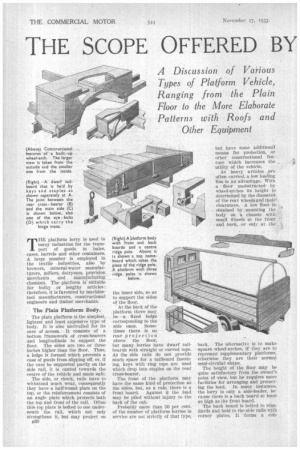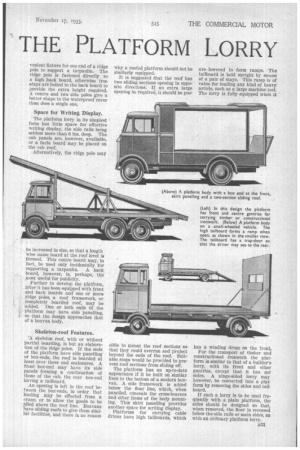THE SCOPE OFFERED BY THE PLATFORM LORRY T HE platform lorry
Page 44

Page 45

If you've noticed an error in this article please click here to report it so we can fix it.
is used in many industries for the transport of goods in bales, cases, barrels and other containers. A large number is employed in the textile industries, also by brewers, mineral-water manufacturers, millers, dairymen, provision merchants and . manufacturing chemists. The platform is suitable for bulky or lengthy articles: therefore, it is favoured by machinetool manufacturers, constructional engineers and timber merchants.
The Plain Platform Body.
The plain platform is the simplest, lightest and least expensive type of body. It is also unrivalled for its ease of access. It consists of a bottom framework of cross-bearers and longitudinals to support the floor. The sides are two or three inches higher than the floor. Thus, a ledge is formed which prevents a case of goods from slipping off, or, if the case be supported partly on the side rail, it is canted towards the centre of the vehicle and made safe.
The side, or chock, rails have to withstand much wear, consequently they have a half-round plate on the top, or the reinforcement consists of an angle plate which protects both the top and front of the rail.. Often this top plate is bolted to one underneath the rail, which not only strengthens it, but may project on .s30 the inner side, so as to support the sides of the floor.
At the back of the platform there may be r a fixed ledge corresponding to the side ones. Sometimes there is no rear projection above the floor, but many lorries have dwarf tailboards with straight or curved tops. As the side rails do not provide much space for a tailboard fastening, keys with ring tops are used which drop into staples on the rear cross-bearer.
The front of the platform may have the same kind of protection as the sides, but, as a rule, there is a front board. Against it the load may be piled without injury to the back of the cab.
Probably more than 50 per cent. of the number of platform lorries in service are not strictly of that type, but have some additional means for protection, or other constructional feature which increases the utility of the vehicle.
As heavy articles fire often carried, .a low loading line is an advantage. With a• floor unobstructed • by wheel-arches its height is determined by the.diameter of the rear wheels fl 0140 r clearances. A low floor is obtained by mounting the body on a chaRsis with small *heels at the front and back, . or only at the
back. The alternative is. to make square wheel-arches, if they are to represent supplementary platforma, otherwise they are their normal semi-circular shape.
The height of the floor may be quite satisfactory from the owner's point of view, but he requires more facilities for arranging and protecting the load. In many instances, the lorry is only a side-loader, because there is a back board at least as high as the front board.
The back heard is bolted to standards and held to the side rails with corner plates. It forms a edit venient fixture for one end of a ridge pole to support a tarpaulin. The ridge pole is fastened directly to a high back board, otherwise iron stays are bolted to the back board to provide the extra height required. A centre and two side poles give a better shape to the waterproof cover than does a single one,
Space for Writing Display.
The platform lorry in its simplest form has little space for effective writing display, the side rails being seldom more than 6 ins. deep. The cab panels are, however, available, or a facia board may be placed on the cab root.
Alternatively, the ridge pole may be increased in size, so that a length wise name board at the roof level is formed. This centre board may, in fact, be used only incidentally for supporting a tarpaulin. A back board, however, is, perhaps, the most useful for publicity.
Further to develop the platform, after it has been equipped with front and back boards and one or more ridge poles, a roof framework, or completely boarded roof, may be added. One or both ends of the platform may have side panelling, so that the design approaches that of a boxvan body.
Skeleton-roof Features.
'A skeleton roof, with or without partial boarding, is but an elaboration of the ridge poles. If the ends of the platform have side panelling or box-ends, the roof is boarded at least over these end enclosures. A front box-end may have its side panels forming a continuation of those of the cab, the rear box-end having a tailboard.
An opening is left in the roof between the box-ends, in order that loading may be effected from a crane, or to allow the goods to be piled above the roof line. Boxvans have sliding roofs to give them similar facilities, and there is no reason why a roofed platform should not be similarly equipped.
It is suggested that the roof has two sliding sections opening in opposite directions. If an extra large opening be required, it should be pos:
Bible to mount the roof sections so that they could overrun and project beyond the ends of the roof. Suitable stops would be provided to prevent roof sections from sliding off.
The platform has an ukto-date appearance if it be built on similar lines to the bottom of a modern boxvan. A side framework is added below the floor line, which, when panelled, conceals the cross-bearers and other items of the body mounting. This skirt panelling provides another space for writing display.
Platforms for carrying cable drums have high tailboards, which are .lowered to form ramps. The tailboard is held upright by means of a pair of stays. This ramp is of value for loading any kind of heavy article, such as a large machine tool. The lorry is fully equipped when it has a winding drum on the front.
For the transport. of timber and constructional ironwork the platform is similar to that of a builder's lorry, with its front and other gantries, except that it has not sides. A ninge-sided lorry may however, be converted into a platform by removing the sides and tailboard.
If such a lorry is to be used frequently with a plain platform, the sides should be designed so that, when removed, the floor is recessed below the side rails or main sides, as with an ordinary platform lorry.




























































































